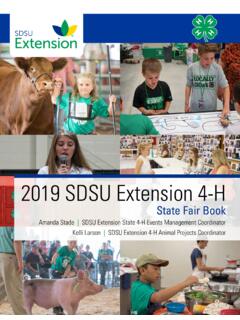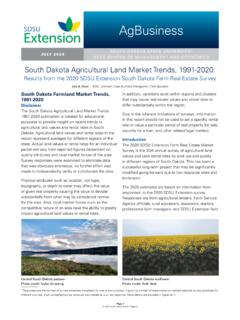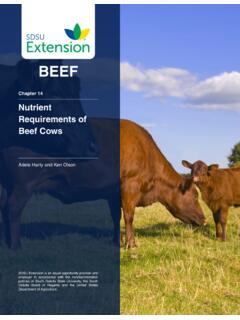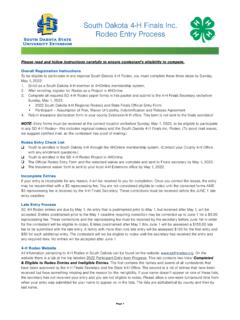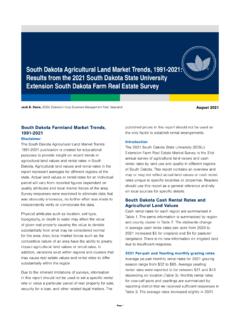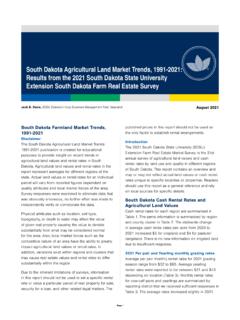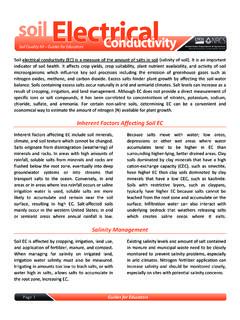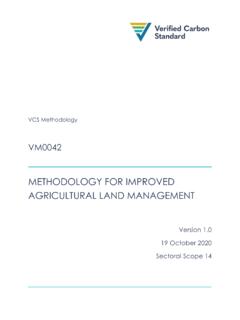Transcription of Fertilizer Recommendations Guide
1 FertilizerRecommendations GuideReview and Revision: Jason Clark | Assistant Professor & SDSU Extension Soil Fertility SpecialistEC750 Original Authors: 2005 Jim Gerwing | Extension Soil Specialist Ron Gelderman | Soil Testing Program ManagerDepartment of Agronomy, Horticulture & Plant ScienceCollege of Agriculture, Food & Environmental SciencesContentsIntroduction ..1 Soil Test Categories ..1 Nitrogen ..1 Deep nitrate test ..1 Legume credits ..1 Manure credits ..2 Nutrient Recommendation Equations used by used by SDSU Extension ..3 Phosphorus and Potassium.
2 4 Seed-Placed Fertilizer ..4 Nitrogen, Phosphorus, and Potassium Recommendation Tables and StatementsCorn ..5 Corn silage ..6 Sorghum ..7 Sunflower ..8 Soybean ..9 Edible bean ..10 Field Pea, Lentil, & Chickpea (Garbanzo Bean) ..11 Wheat & Rye ..12 Oats ..13 Feed Barley ..14 Malting Barley ..15 Buckwheat ..16 Safflower ..17 Mustard, Rapeseed, & Canola ..18 Flax ..19 Alfalfa ..20 Grass ..21 Sudan Grass & Forage Sorghum ..22 Millet ..23 Potatoes ..24 Garden & Lawn ..25 Zinc Recommendations for Corn, Sorghum, Flax, Potatoes and Edible Beans ..27 Sulfur Recommendations .
3 27 Chloride Recommendations ..28 Magnesium Recommendation ..28 Calcium Recommendation ..28 Iron Recommendation ..29 Boron Recommendation ..29 Copper Recommendation ..29 Manganese Recommendation ..29 Lime Recommendation ..30 Salts and Sodium ..31 Page 1 2019, South Dakota Board of RegentsFertilizer Recommendation GuideJason Clark Assistant Professor & SDSU Extension Soil Fertility SpecialistEC 750 Original Authors: 2005 Jim Gerwing Extension Soil SpecialistRon Gelderman Soil Testing Program ManagerSDSU Extension Fertilizer Recommendations are based on field research in South Dakota and neighboring states.
4 However, information from outside this region is used where only limited local data was available . The tables were developed as part of continuing cooperation between these states to standardize Recommendations across the three-state area .The Recommendations in the tables are generated by equations and, therefore, change consistently across yield goals and soil test levels . Due to space limitations, only the Recommendations for selected yield goals and the mean soil test level of each soil test range (very low, low, medium, high, and very high) have been printed in this Guide .
5 Where specific yield goals and/or soil test values are not listed in the table, Recommendations can be determined by interpolating between the nearest two yield goals and soil test levels . In addition, Recommendations for nitrogen, phosphorus, and potassium also can be calculated using the equations listed in each crop nutrient recommendation section and summarized in Table 3 . Statements that clarify or modify the Recommendations are listed in each crop nutrient recommendation section . Soil Test CategoriesSoil test levels for all nutrients in the tables except nitrate nitrogen have been put into categories labeled very low (VL), low (L), medium (M), high (H), and very high (VH).
6 These categories represent a decreasing probability of a yield response to broadcast Fertilizer ranging from more than an 80% chance of a response at the very low soil test level to less than a 20% chance when soil tests are in the very high range . The probability of a yield response to Fertilizer in the medium soil test range is estimated at between 40 and 60% . Soil test categories are listed in Table 1 . Soil test categories for the nitrate-nitrogen test are not given because calibration of the nitrate-nitrogen test depends on yield goal and crop to be grown.
7 Categories listed for iron, manganese, copper, boron, calcium, and magnesium are not based entirely from calibration studies in this area because response to these nutrients is extremely limited in South Dakota . Manganese, copper, boron, calcium, and magnesium deficiencies have not been confirmed in South Dakota .NitrogenThe soil N plus supplemental N required column in the tables is not the amount of Fertilizer N to apply . Nitrogen credits must be subtracted from this requirement . The remainder is the N Fertilizer recommendation . Nitrogen credits include:a) Deep Nitrate Soil Test: If a 2-foot nitrate soil test is not available, then long-term average soil tests of 40 lbs/ac for re-cropped fields and 75 lbs/ac for fallow fields should be used when making an N recommendation.
8 If a 2- to 4-foot deep nitrate test is available and it is more than 30 lbs/ac, then reduce the nitrogen recommendation by 4 lbs/ac for each 5-lb increment above 30 lbs . For example, if there are 50 lbs of NO3-N in the 2-4-foot depth, credit 16 lbs (80% of 20 lbs) .b) Legume credits: Legume credits used in South Dakota are listed in Table 2 .|| |agronomySOUTH DAKOTA STATE UNIVERSITY AGRONOMY, HORTICULTURE & PLANT SCIENCE DEPARTMENTMARCH 2019 Page 2 2019, South Dakota Board of RegentsTable 1 . Soil Test Calibration Levels Used in South Dakota and the probability that Fertilizer applications will increase crop yield.
9 NutrientSoil TestVery Low (VL)Low (L)Medium (M)High (H)Very High (VH)Probability of yield response80%60-80%40-60%20-40%<20%ppm extractable (0-6 inch samples)PhosphorusBr ay P -10-56 -1011-1516-2021+PhosphorusOlsen0-34 -78 -1112-1516 +PotassiumNH4Ac0-4041-8081-12 0121-16 0161+Zinc (1) +Iron (2)DTPA + Manganese (3)DTPA 0 + Copper (3)DTPA 0 - 0 . + Boron (3)Hot H2O + Magnesium (3)NH4Ac0 -1011-2 021-3031-4041+Calcium (3)NH4Ac0 -10 0101-200201-300301-400401+lbs /ac 2 ftSulfur500 ppm P0-910 -1920-2930-3940+Chloride (4) Ca(NO3)0 -1516-3031-4546-6061+(1) Calibration only for corn, sorghum, flax, potatoes, and edible beans(2) pH is a better indicator to predict iron deficiency(3) Deficiencies have not been confirmed in South Dakota(4) Calibration only for wheat, barley, and ryec) Manure: The Fertilizer value of manure varies with age, type of animal, storage, and application procedures.
10 The only accurate method of determining manure nutrient credits is with a manure analysis . Manure analysis should include both inorganic (ammonia) nitrogen and organic nitrogen . Credit 35% of the organic nitrogen in manure . Credit 98% of the inorganic nitrogen if liquid manure is injected below the soil surface . If manure is broadcast on the surface and incorporated within 24 hours, credit 90% of the inorganic N . If it is not incorporated until 5 days after application or later, credit only 20% of the inorganic N since most inorganic N may have volatilized as manure dries.

